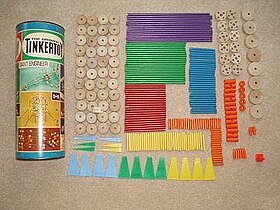Tinkertoy
The Tinkertoy construction set is a toy for children. It was in 1914 by Charles H. Pajeau and Robert Pettit in Evanston created - one year after the Erector Set the AC Gilbert Company . Pajeau, a stonemason , designed the toy after seeing children play with pens and empty spools of thread. He and Pettit launched Tinkertoy as a toy that would stimulate children's imaginations.
The cornerstone of the set consists of a wooden spool about 5 centimeters in diameter. A hole is drilled every 45 degrees around the circumference, as well as through the middle, but this hole, in contrast to the circumference holes, is completely drilled through. Because of the different lengths of the sticks, the set is based on the Pythagorean theorem .
Tinkertoy was popularized in and around Chicago through posters showing model ferris wheels . Tinkertoy was used to create surprisingly complex machines, including Danny Hillis ' tic-tac-toe computer, now in the Computer History Museum in Mountain View, and a robot at Cornell University in 1998 .
Hasbro owns the sales rights to Tinkertoy and produces the plastic and wood components.
Standard parts
In addition to the parts already described, a Tinkertoy set contains:
- Wheels thinner than the coils but larger in diameter. Like the coils, they have a transition fit in their center.
- Cover caps , originally made of wood, later made of plastic, cylindrical pieces with an axis-shaped hole that is adapted to the bars.
- Fittings , small, cylindrical pieces (actually wood, plastic later), approximately 5 centimeters long and one centimeter in diameter, with holes at each end and a through hole in the middle.
- "Part W" , roughly the same size and shape as the coils, but with circumferential holes 90 degrees apart, holes in the center and four through holes that run parallel to the hole in the center. Coils have a groove on the outside, "Part W" has two parallel ones. It is intended for constructions like “cage” or “lantern gear”.
- Short, pointed sticks (originally wood, later plastic), mostly red, flags, mostly green plastic, and various other small parts.
The sticks are notched at both ends so that they hold better in the holes they are inserted into, but also so that cards, flags and threads can be inserted into the notches. They are colored according to size, in the 1960s set they were orange, yellow, blue, red, green and purple, increasing in size. Each longer rod is the next smaller size times the square root of two; so two rods of the same size can connect with one of the next larger ones and form an isosceles and right-angled triangle.
There are also sets with battery-operated motors, so the movements of the machines can be set to different speeds.
swell
- Strange, Craig. A guide for Tinkertoy collectors . ISBN 0-89145-703-8 .
- Alexander Dewdney. The Tinkertoy Computer and Other Machines (English) . ISBN 0-7167-2491-X .
